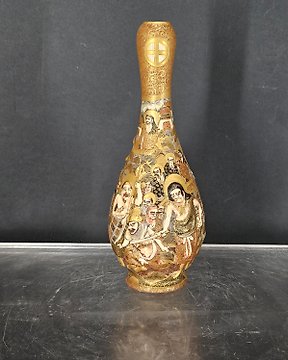
Vas - Ceramică - Marked 'Dai Nihon Chōshūzan Satsuma Jissei Kagetsu ga' 大日本長州山薩摩實生鹿月画 - Japonia - Meiji period (1868-1912)
Nr. 83242669

Nr. 83242669

Large 52 cm Satsuma stoneware palace vase from Meiji - Era ( 1868 - 1912 ) Japan, Satsuma Province, handmade with
Samurai, Chrysanthemum and Japanese Shippo motif, richly gilded.
Height: 52cm
Width: 26cm
Weight: 3658g
These Satsuma stoneware palace vase were made during the Meiji period in Japan, in Satsuma Province, which lasted from 1868 to 1912.
This era was marked by a strong cultural change and an opening of Japan to the West.
The imposing 52 cm high and 26 cm wide vase was probably one of several palace vases and was made as a representative work of art that showcased the artistry and cultural identity of Japan. Your floor mark may be an abbreviation for a central position. It is available in the colors red, black and yellow and is covered with gold and the handles are gold-plated. The vase has a top glaze with rich ornamentation that is noticeable. A visual and tactile experience.
The palace vase features samurai and chrysanthemum motifs, as well as Japanese Shippo patterns.
Samurai were often depicted on Satsuma stoneware because they were central figures in Japanese history and culture. During the period when Satsuma pottery was being produced, samurai had immense social and political importance in Japan. Their depiction on Satsuma ceramics served to honor and celebrate traditional Japanese culture and history. The depiction of samurai on Satsuma ceramics thus underlines the connection of this art form with the rich cultural and historical tradition of Japan.
Chrysanthemums were a commonly used motif on Satsuma stoneware. This flower has a special meaning in Japanese culture and symbolizes longevity, luck and prosperity. The use of chrysanthemum motifs on Satsuma stoneware highlights the art form's deep connection to traditional Japanese aesthetics and the country's cultural richness. What showed up to the west. This palace vase was a political statement that showed Japan as a strong traditional culture to the West.
Satsuma stoneware is a traditional Japanese ceramic made in Satsuma Province in the 17th century. It is known for its rich decoration, often with detailed landscapes, flowers and figures in gold and color painting. Satsuma pottery was particularly popular in the late 19th and early 20th centuries when it was produced for export.
Today, Satsuma stoneware is valued by collectors worldwide and is an important cultural heritage of Japan.
Despite its age of over 150 years, the vase is still in good condition. The vase has a broken spot on the vase head and a chipped spot on the base. The gold on the handles is only minimally rubbed and has craquelure, which is evidence of its age. Otherwise it is in excellent condition and leaves everyone who looks at it speechless.
A must for every lover of Japanese craftsmanship.
Cum să cumperi de la Catawiki
1. Descoperă ceva special
2. Plasează cea mai mare ofertă
3. Fă o plată sigură